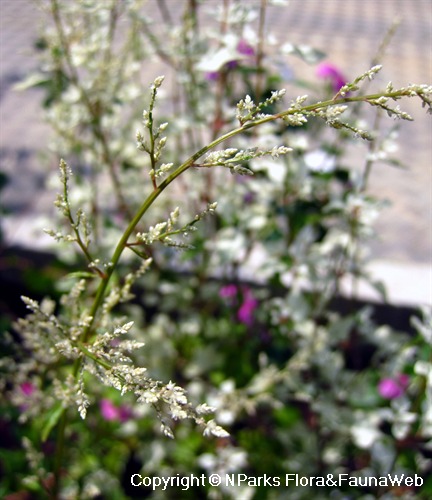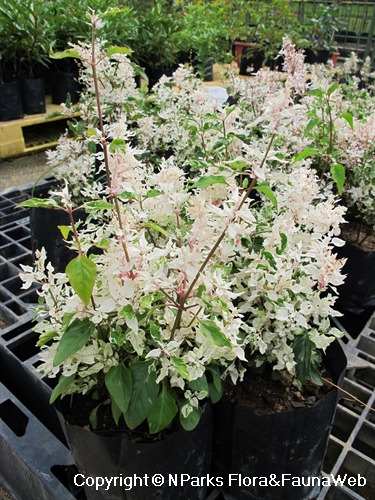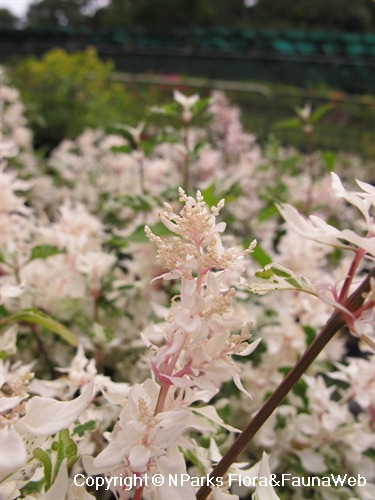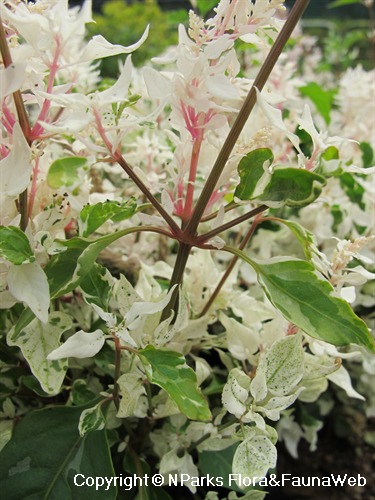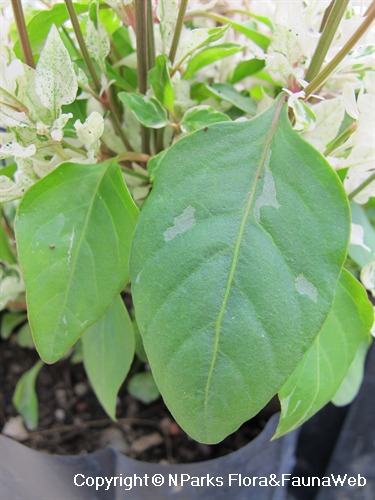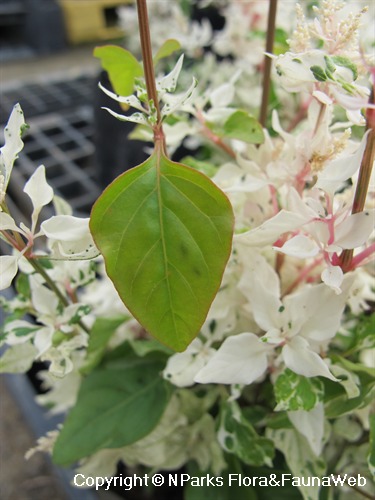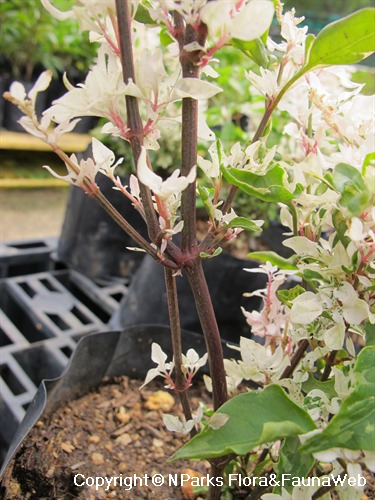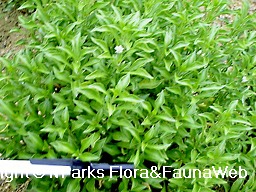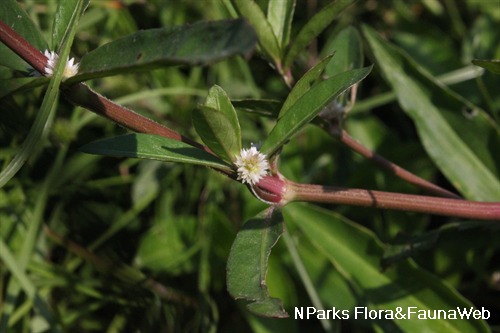
Back
Alternanthera ficoidea 'Snow on the Mountain'
| Family Name: | Amaranthaceae |
| Common Name: | Brazilian Snowflower, Brazilian Snow Flower |
Name
Classifications and Characteristics
| Plant Division | Angiosperms (Flowering Seed Plants) (Dicotyledon) |
|---|---|
| Plant Growth Form | Herbaceous Plant |
| Lifespan (in Singapore) | Perennial |
| Mode of Nutrition | Autotrophic |
| Plant Shape | Compact |
| Maximum Height | 0.3 m to 0.45 m |
Biogeography
| Preferred Climate Zone | Tropical |
|---|
Description and Ethnobotany
| Growth Form | Low-growing, herbaceous perennial with erect stem. |
|---|---|
| Foliage | Opposite leaves are narrowly ovate to ovate with wavy leaf margin (6 cm long). Mature leaves are mostly green with irregular whitish patches; young leaves are usually pure white, but occasionally have some small, green spots. |
| Stems | Stem tips are light pink. |
| Flowers | Small, white flowers are stalkless or have short stalks. They are arranged in small clusters in the leaf axils. |
| Fruit | Dry, indehiscent fruit are utricles and each contain 1 reddish brown seed. |
| Cultivation | This cultivar is fast-growing. It should be planted in fertile, well-draining soil that is kept moist. Feed with a granular 10-10-10 fertilizer. Specimen plants should be spaced 30 cm apart, whereas groundcover plants should be spaced 10 cm apart. Plants that become leggy should be hard pruned. Flowers should be removed before they set seed to prevent excessive spread of seedlings. |
| Etymology | The genus "Alternanthera" is derived from the Latin words for alternating ("alternans") and anther ("anthera"). The reference is to the alternating arrangement of stamens and pseudostaminodes (a structure similar to a staminode which is a modified stamen that does not produce pollen). The species epithet "ficoidea" is derived from the Latin word for fig ("ficus") and means resembling a fig. |
Landscaping Features
| Landscaping | This cultivar is grown for its ornamental foliage. The young, white leaves are densely packed near the stem tips and resemble a thick cluster of small, white flowers. Mature leaves are variegated, providing contrast with other green plants. This cultivar is suitable for edging, container plantings and groundcovers. |
|---|---|
| Desirable Plant Features | Ornamental Foliage |
| Landscape Uses | Flowerbed / Border, Container Planting |
| Thematic Landscaping | Moonlight Garden |
Plant Care and Propagation
| Light Preference | Full Sun |
|---|---|
| Water Preference | Moderate Water |
| Plant Growth Rate | Fast |
| Rootzone Tolerance | Fertile Loamy Soils, Well-Drained Soils |
| Propagation Method | Stem Cutting |
| Propagation Method Remarks | Propagate by stem cuttings. Although seeds will germinate, the foliage colour of the new plants may differ from the parent plant. |
Foliar
| Foliage Retention | Evergreen |
|---|---|
| Mature Foliage Colour(s) | Green, White |
| Mature Foliage Texture(s) | Smooth |
| Foliar Type | Simple / Unifoliate |
| Foliar Arrangement Along Stem | Opposite |
| Foliar Shape(s) | Non-Palm Foliage (Ovate) |
| Foliar Venation | Pinnate / Net |
| Foliar Margin | Entire - Wavy / Undulate |
| Foliar Apex - Tip | Acute |
| Foliar Base | Rounded / Obtuse |
| Typical Foliar Area | Microphyll ( 2.25cm2 - 20.25 cm2 ) |
Non - Foliar and Storage
| Stem Type & Modification | Herbaceous |
|---|---|
| Root Type | Underground (Tap Root) |
Floral (Angiosperm)
| Flower & Plant Sexuality | Bisexual Flowers |
| Flower Colour(s) | White |
|---|---|
| Flower Symmetry | Radial |
Fruit, Seed and Spore
| Fruit Classification | Simple Fruit |
|---|---|
| Fruit Type | Indehiscent Dry Fruit |
Image Repository
Others
| Master ID | 29793 |
|---|---|
| Species ID | 4102 |
| Flora Disclaimer | The information in this website has been compiled from reliable sources, such as reference works on medicinal plants. It is not a substitute for medical advice or treatment and NParks does not purport to provide any medical advice. Readers should always consult his/her physician before using or consuming a plant for medicinal purposes. |

